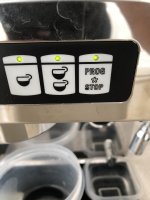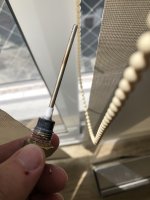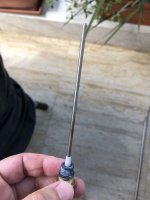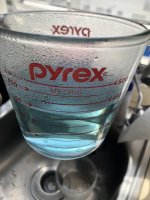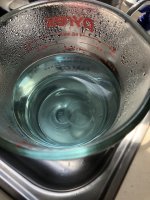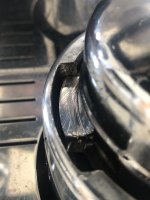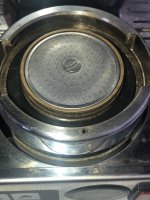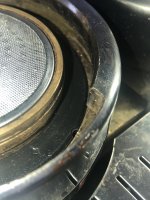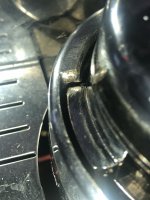I picked up a Livia 90 semi auto on craigslist recently. I did a similar descale and it too makes excellent shots. However when I steam the milk with the "turbo tip", it screams like a jet engine on full afterburner when the milk temp gets above 80F. I start with the tip submerged, then raise it until the side holes just break the surface creating that quiet sucking sound. I hold it there until about 70F, and push it down again. Then at 80, all hell breaks loose. Its so loud you cant hear the person next to you. Any ideas?
You are using an out of date browser. It may not display this or other websites correctly.
You should upgrade or use an alternative browser.
You should upgrade or use an alternative browser.
The Pasquini Saga
- Thread starter Mick
- Start date
I have no idea but . . . maybe turn it off and finish on residual heat?
Can you get after market tips? That might help.
- Thread starter
- #24
I picked up a Livia 90 semi auto on craigslist recently. I did a similar descale and it too makes excellent shots. However when I steam the milk with the "turbo tip", it screams like a jet engine on full afterburner when the milk temp gets above 80F. I start with the tip submerged, then raise it until the side holes just break the surface creating that quiet sucking sound. I hold it there until about 70F, and push it down again. Then at 80, all hell breaks loose. Its so loud you cant hear the person next to you. Any ideas?
It is normal to get a screaming when frothing.
Can you get after market tips? That might help.
I replaced the 1 hole tip with a 3 hole tip. I find that it froths faster and more consistently (at least for me anyway).
It's still rather loud but all machines I have owned have been loud when frothing.
The machine looks to have been put away when it stopped making coffee. No buggered up parts inside and all of the dated parts are the same age as the machine (21st week of 2005). I was the first person inside the machine which is nice to not have to un-fix some cowboy's "repair"
I descaled the boiler first by running a full reservoir of citric acid through it one boiler full at a time. I pulled the wire off of the boiler fill sensor and opened the steam valve to fill the boiler to the top with water so that I got the entire boiler covered with the acid. I would let it sit in the boiler for half an hour then turn the machine on and run the boiler empty through the water dispenser, let it fill again and turn it off for another half hour. I did this until the water stopped coming out milky/chalky/yellow and started to come out blue (down to the copper in the boiler, heating coils, and all of the tubing). I then ran 2 full reservoir of fresh water through it using the same method, fill the boiler, let it sit, drain the boiler and refill again. that took the better part of Thursday and was an all day affair but it is squeaky clean now.
Yesterday I got the 3 way valve in so had to descale the heat exchanger since no water would run through the heat exchanger with the 3 way valve inoperative, otherwise I could have done both the boiler and heat exchanger at the same time. I descaled the heat exchanger by removing all of the tubing going to it and putting the copper tubes into a glass with citric acid in it to remove the calcium deposits inside of the tubing. I used a 30 ml syringe and a 18 gauge blunt irrigation needle (the same one I use for refilling my fountain pen cartridges) and filling the heat exchanger with acid. I let it sit for about a half hour, put one of the tubes back on and put on the plastic over flow tube from the bottom of the 3 way valve (that fit on the other HX fitting) and blew the heat exchanger dry. Then I filled it again. I did this over and over until I used up 1 cup of critic acid mixture.
Then I put 2 cups of water through it to flush out the acid. I put the 3 way valve on and fired it up. Worked like new. Strong flow, good boiler temp. perfect brew temp.
Flipped it on its top and chiseled out the old portafilter gasket which looked to be the original one from 2005 as it was busted up real bad and leaked something fierce.
I mixed the citric acid 1 tbl to 1 cup of water which was mild yet strong enough to remove all of the calcium deposits in the water system.
Citric acid is a food additive and is used in soft drinks and other products where a sour taste is wanted. It can be eaten in a raw powder form (if you can handle the sour) so it is one of the safest acid descalers you can use. It also does not damage any of the seals and gaskets as it is rather mild. It does take a little longer to work than commercial descaling products but those are caustic and you need to make sure all of it is out before using the machine.
After getting it up and running I back flushed it with 1/2 tsp of Cafiza. From the gunk that came out it looked like this was the first time it was back flushed too.
Now it is looks and works like a new machine (better then it did when it was new as the 3 way valve is larger than the original).
Got it off of eBay and the seller covered the $150 cost of the parts (valve was $98 alone + gaskets and food grade high temp lube).
I've got about 1/3 the cost of a new machine into it and am happy with that
Hi,The machine looks to have been put away when it stopped making coffee. No buggered up parts inside and all of the dated parts are the same age as the machine (21st week of 2005). I was the first person inside the machine which is nice to not have to un-fix some cowboy's "repair"
I descaled the boiler first by running a full reservoir of citric acid through it one boiler full at a time. I pulled the wire off of the boiler fill sensor and opened the steam valve to fill the boiler to the top with water so that I got the entire boiler covered with the acid. I would let it sit in the boiler for half an hour then turn the machine on and run the boiler empty through the water dispenser, let it fill again and turn it off for another half hour. I did this until the water stopped coming out milky/chalky/yellow and started to come out blue (down to the copper in the boiler, heating coils, and all of the tubing). I then ran 2 full reservoir of fresh water through it using the same method, fill the boiler, let it sit, drain the boiler and refill again. that took the better part of Thursday and was an all day affair but it is squeaky clean now.
Yesterday I got the 3 way valve in so had to descale the heat exchanger since no water would run through the heat exchanger with the 3 way valve inoperative, otherwise I could have done both the boiler and heat exchanger at the same time. I descaled the heat exchanger by removing all of the tubing going to it and putting the copper tubes into a glass with citric acid in it to remove the calcium deposits inside of the tubing. I used a 30 ml syringe and a 18 gauge blunt irrigation needle (the same one I use for refilling my fountain pen cartridges) and filling the heat exchanger with acid. I let it sit for about a half hour, put one of the tubes back on and put on the plastic over flow tube from the bottom of the 3 way valve (that fit on the other HX fitting) and blew the heat exchanger dry. Then I filled it again. I did this over and over until I used up 1 cup of critic acid mixture.
Then I put 2 cups of water through it to flush out the acid. I put the 3 way valve on and fired it up. Worked like new. Strong flow, good boiler temp. perfect brew temp.
Flipped it on its top and chiseled out the old portafilter gasket which looked to be the original one from 2005 as it was busted up real bad and leaked something fierce.
I mixed the citric acid 1 tbl to 1 cup of water which was mild yet strong enough to remove all of the calcium deposits in the water system.
Citric acid is a food additive and is used in soft drinks and other products where a sour taste is wanted. It can be eaten in a raw powder form (if you can handle the sour) so it is one of the safest acid descalers you can use. It also does not damage any of the seals and gaskets as it is rather mild. It does take a little longer to work than commercial descaling products but those are caustic and you need to make sure all of it is out before using the machine.
After getting it up and running I back flushed it with 1/2 tsp of Cafiza. From the gunk that came out it looked like this was the first time it was back flushed too.
Now it is looks and works like a new machine (better then it did when it was new as the 3 way valve is larger than the original).
Got it off of eBay and the seller covered the $150 cost of the parts (valve was $98 alone + gaskets and food grade high temp lube).
I've got about 1/3 the cost of a new machine into it and am happy with that
Thanks for this wonderful tread. Really push me to upgrade from Gagglia Classic to the Pasquini 90 Auto. I just got my unit and really need some help. First time doing this.
I’ll try to follow up the instruction to get the boiler and the HX descale. Its looks pretty forward with your explanation. I already test the machine and heat well. The condition of the parts looks good to me. I got a problem that i’ll Try to explain in the best way posible. When I turn on the machine I only get water to brew only when I pushed the Prog button, otherwise when I pressed the one or two cups button I get click sound inside and nothing happens. Also, when I leaved the program buttom pressed to program the one/ two cups buttons instead of get flashing signal the 3 buttons got ilumintated. When I doing this process both buttons works, only with the process not after. I’m uploading a photo.
I don’t if you still looking this forum, I hope you do.
thanks in advance
Attachments
- Thread starter
- #27
Welcome to B&B.......
I'll try and see if I can help you out but from your first post it appears to be either a control panel issue or the valve is so clogged that it does not open when triggered (the clicking).
Do you get water out of the spigot and frothing tube when you open the valves?
IF you do, you can descale the boiler and the tubes.
Don't let any descaling soloution set in the boiler. Flush it with 2 full changes of water in the reservoir.
You may want to take the screen off of the group and see if it is clogged. The machine will run without the screen so you "may" be able to descale the head group and valves too.
I'll try and see if I can help you out but from your first post it appears to be either a control panel issue or the valve is so clogged that it does not open when triggered (the clicking).
Do you get water out of the spigot and frothing tube when you open the valves?
IF you do, you can descale the boiler and the tubes.
Don't let any descaling soloution set in the boiler. Flush it with 2 full changes of water in the reservoir.
You may want to take the screen off of the group and see if it is clogged. The machine will run without the screen so you "may" be able to descale the head group and valves too.
Hi Mick,
Thanks for your fast reply. In response to your question I’m getting water from the spigot and the steam wand. I also getting water from the brew group, but only when I pressed the PROG button. No the other.
I definitely will descale the boiler. I’m getting the tread sealer and the acid for the descaling.
Thanks again for the support.
Thanks for your fast reply. In response to your question I’m getting water from the spigot and the steam wand. I also getting water from the brew group, but only when I pressed the PROG button. No the other.
I definitely will descale the boiler. I’m getting the tread sealer and the acid for the descaling.
Thanks again for the support.
- Thread starter
- #29
Rule out scale first (clean the valves and boiler). That is the cheap way to start. Make sure to flush with clean water at least 2 reservoirs of clean water through everything.
After that you need to isolate either the valves or the control panel (electronics). I insulated between boiler and electronics when I did my mods. Too many times these get left on for extended periods of time and the heat is a killer on electronic parts
After that you need to isolate either the valves or the control panel (electronics). I insulated between boiler and electronics when I did my mods. Too many times these get left on for extended periods of time and the heat is a killer on electronic parts
Hi Mick,Rule out scale first (clean the valves and boiler). That is the cheap way to start. Make sure to flush with clean water at least 2 reservoirs of clean water through everything.
After that you need to isolate either the valves or the control panel (electronics). I insulated between boiler and electronics when I did my mods. Too many times these get left on for extended periods of time and the heat is a killer on electronic parts
thanks again. I live outside of the states and can’t get any Citric Acid Food Grade down here. So I’ll order from amazon. Meanwhile I took out both boiler probes sensor to see how bad the scale was and this what i found. See pictures attached. The other comment, I found strange there was none tread sealant or anything when I loose the probes. I believe that the previous owner change the boiler. Do you think I should go ahead and do the descaling process anyway?
I was looking one of your pictures and I noticed that your CPU is a different brand and also your relay is bigger. My Livia is series 38001 and I don’t have a clue of the production date.
Thanks for all the support.
Christian M.
Attachments
- Thread starter
- #31
You can use a commercial descaling product if you can't locate citric acid. Cost is a little higher initial but cost per use is only pennies.
Descale is a must on a unknown machine. It gives you a known starting point for future maintenance
I did not use any sealer on threads. It is unnecessary.
You may only need to program single and double shots if you get flow when pressing starrt
Remove the group screen and descale.
Then backflush.
When you have these done, reprogram your shots using a measuring cup to get the single and double volume.
Descale is a must on a unknown machine. It gives you a known starting point for future maintenance
I did not use any sealer on threads. It is unnecessary.
You may only need to program single and double shots if you get flow when pressing starrt
Remove the group screen and descale.
Then backflush.
When you have these done, reprogram your shots using a measuring cup to get the single and double volume.
Hi Mick,You can use a commercial descaling product if you can't locate citric acid. Cost is a little higher initial but cost per use is only pennies.
Descale is a must on a unknown machine. It gives you a known starting point for future maintenance
I did not use any sealer on threads. It is unnecessary.
You may only need to program single and double shots if you get flow when pressing starrt
Remove the group screen and descale.
Then backflush.
When you have these done, reprogram your shots using a measuring cup to get the single and double volume.
Just want to confirm with you about the right procedure before to move forward.
Descaling process.
Citric Acid Proportion = 1 tablespoon + 1 cup of water.
1- Fill the water reservoir with citric acid or descaling solution
2- Unplugged the 2 sensors units of the boiler.
3- Open the steam valve with the machine powered on and let the boiler fill.
4- Let the solution works for 30 mins
5- Run the water trough the brew group without the screen.
6- Repeat the process with fresh water at least with 2 full reservoir to remove any residues.
Do i need to remove the HX parts and do the cleaning process that you did? Or it won’t be necessary with process mentioned above.
Sorry if I making silly questions, But I don’t want to screw up the process.
thanks in advance,
Christian M
- Thread starter
- #33
You don't want the boiler to heat up too much with the acid in it.
As soon as the boiler is filled and you are getting acid out of the steam wand and hot water spigot and brew head, shut the valves and power it off to sit.
.
As soon as the boiler is filled and you are getting acid out of the steam wand and hot water spigot and brew head, shut the valves and power it off to sit.
.
Hi Mick,You can use a commercial descaling product if you can't locate citric acid. Cost is a little higher initial but cost per use is only pennies.
Descale is a must on a unknown machine. It gives you a known starting point for future maintenance
I did not use any sealer on threads. It is unnecessary.
You may only need to program single and double shots if you get flow when pressing starrt
Remove the group screen and descale.
Then backflush.
When you have these done, reprogram your shots using a measuring cup to get the single and double volume.
Just want to confirm with you about the right procedure before to move forward.
Perfect. Thanks I’ll keep you postedYou don't want the boiler to heat up too much with the acid in it.
As soon as the boiler is filled and you are getting acid out of the steam wand and hot water spigot and brew head, shut the valves and power it off to sit.
.
Hi Mick,Hi Mick,
Just want to confirm with you about the right procedure before to move forward.
Perfect. Thanks I’ll keep you posted
Just want to report back regarding the descale process. I got my Acid Citric Food Grade, and mix it with a ratio of 1tbl to 1 cup of water. My first intent to disconnect the boiler sensor didn’t allow me to get water of any of the valves or the brew group. The 3 buttons were flashing continuously and without any funcionallty. I opened the steam, spigot and the brew group until i got the acid solution. I let it set for 30 mins and my fist flush out from the spigot came like blue (see picture uploaded), I didn’t get any milky water or yellow at all. I asking myself if this acid is to mild for descaling ? Should I get something like dezcal and try again?
Another question to you as you’re using the machine for while. When I opened the spigot to flush the water, i notice that the pressure drop ( this normal), the pump run also, but I get to the point the water is runni out (in about 2 cups of water). Is that normal or the water pump is no pumping enough??
thanks again for the support.
Christian
Attachments
- Thread starter
- #36
The blue is copper which shows your machine has little or no buildup.
The boiler is small so you cannot get large volumes of hot water before it runs out. It is good for 3-4 Americanos (espresso + water) before needing to catch up.
The pump is a high pressure low volume so can only do a coffee cup (6 oz) of hot water before slowing down.
These are home machines so have limitations
.
The boiler is small so you cannot get large volumes of hot water before it runs out. It is good for 3-4 Americanos (espresso + water) before needing to catch up.
The pump is a high pressure low volume so can only do a coffee cup (6 oz) of hot water before slowing down.
These are home machines so have limitations
.
Thanks for your fast response.The blue is copper which shows your machine has little or no buildup.
The boiler is small so you cannot get large volumes of hot water before it runs out. It is good for 3-4 Americanos (espresso + water) before needing to catch up.
The pump is a high pressure low volume so can only do a coffee cup (6 oz) of hot water before slowing down.
These are home machines so have limitations
.
Hi Mick,
I’m stuck again with my Pasquini. I order a new PF and for some reason, I couldn’t fit in the Brew group. I noticed that the gasket was very toasted, in fact in the process of taking it out, was in pieces. I replace the gasket and the screen, and still have the same problem, now I barely can fit the PF without any filter in. I stil get the PF with filter in.
I notice that gasket is depth is higher that the cooper border of the Brew group.
Please see pictures attached ( I tried my best). Any of you have this issues with your machine?
thanks in advance.
I’m stuck again with my Pasquini. I order a new PF and for some reason, I couldn’t fit in the Brew group. I noticed that the gasket was very toasted, in fact in the process of taking it out, was in pieces. I replace the gasket and the screen, and still have the same problem, now I barely can fit the PF without any filter in. I stil get the PF with filter in.
I notice that gasket is depth is higher that the cooper border of the Brew group.
Please see pictures attached ( I tried my best). Any of you have this issues with your machine?
thanks in advance.
Attachments
I have worked on a Pasquini 90S that has the GiCar controller in it. The symptoms were that when turned on the pump would start and the valve(s) would open for brewing and water came out, plus the three LEDs would be lit.
The problem was in the controller, which I opened. WARNING: THE FOLLOWING CAN BE FATAL. IF YOU DO THE FOLLOWING IT IS AT YOUR OWN RISK. YOU NEED TO UNDERSTAND AND KNOW THE RISKS OF WORKING WITH LINE VOLTAGE. With the electronics open, on the bench, I dangerously applied 115Vac and measured some voltages. The controller runs on 5Vdc; it has a 7805 voltage regulator. The regulator is powered from a full-wave bridge and filter capacitor (330uF 35V). The filter capacitor was bad. This was determined by using a DVM (Digital MultiMeter), set to measure AC and measuring across the capacitor. About 2Vac was measured; it should be in the mV range. FYI: The DC voltage should be around 17-25V (don't remember what it exactly was).
Removed the capacitor and verified it was bad using a capacitor meter. Replaced the capacitor (330uF 35V). Now the controller is working fine.
A simple possible solution, if you are certain/find the controller is bad and are going to buy a new one, then before doing so, you can open the controller and simply replace the capacitor (should be only about around $1). Do not use a 25V capacitor, it is too low a voltage rating. If this fixes the controller, great. If not, then you spent $1 to try and save the cost of a new controller.
Not to be insulting, if you have to ask: What is a capacitor? Where do I buy a capacitor? Or don't know how to solder. Then this may not be a job for you. But you might know someone that does know these things.
The capacitor is an aluminum electrolytic and heat is it nemesis. Over time, elevated heat will cause the aluminum electrolytic capacitor to fail sooner rather than later.
The problem was in the controller, which I opened. WARNING: THE FOLLOWING CAN BE FATAL. IF YOU DO THE FOLLOWING IT IS AT YOUR OWN RISK. YOU NEED TO UNDERSTAND AND KNOW THE RISKS OF WORKING WITH LINE VOLTAGE. With the electronics open, on the bench, I dangerously applied 115Vac and measured some voltages. The controller runs on 5Vdc; it has a 7805 voltage regulator. The regulator is powered from a full-wave bridge and filter capacitor (330uF 35V). The filter capacitor was bad. This was determined by using a DVM (Digital MultiMeter), set to measure AC and measuring across the capacitor. About 2Vac was measured; it should be in the mV range. FYI: The DC voltage should be around 17-25V (don't remember what it exactly was).
Removed the capacitor and verified it was bad using a capacitor meter. Replaced the capacitor (330uF 35V). Now the controller is working fine.
A simple possible solution, if you are certain/find the controller is bad and are going to buy a new one, then before doing so, you can open the controller and simply replace the capacitor (should be only about around $1). Do not use a 25V capacitor, it is too low a voltage rating. If this fixes the controller, great. If not, then you spent $1 to try and save the cost of a new controller.
Not to be insulting, if you have to ask: What is a capacitor? Where do I buy a capacitor? Or don't know how to solder. Then this may not be a job for you. But you might know someone that does know these things.
The capacitor is an aluminum electrolytic and heat is it nemesis. Over time, elevated heat will cause the aluminum electrolytic capacitor to fail sooner rather than later.
Last edited:
The blue is copper which shows your machine has little or no buildup.
The boiler is small so you cannot get large volumes of hot water before it runs out. It is good for 3-4 Americanos (espresso + water) before needing to catch up.
The pump is a high pressure low volume so can only do a coffee cup (6 oz) of hot water before slowing down.
These are home machines so have limitations
.
Barely a drip of water will come out of my hot water spigot. I imagine theres scale as I can see some on the bottom of the reservoir tip. Will the citric acid descale process work for this or do I need to start taking things apart? Just wondering if this part is so clogged is it still a good idea to descale?
Similar threads
- Replies
- 2
- Views
- 2K
- Replies
- 3
- Views
- 1K
- Replies
- 54
- Views
- 9K
- Replies
- 28
- Views
- 4K

